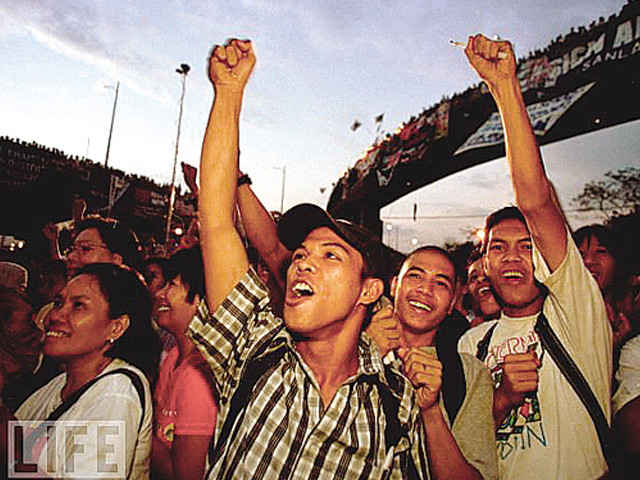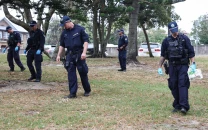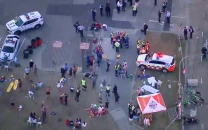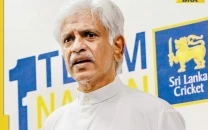Power to the people
A look back at some of the greatest moments in history reveals who revolutions' real heroes are.

Power to the people
Who: Tenth president of the Phillipines
Years in power: 1965 to 1986
Claim to infamy: His regime was accused of murder, nepotism, corruption and human rights violations. According to Transparency International, Marcos is the second most corrupt head of government ever.
Downfall: Marcos was implicated in the assassination of Benigno Aquino, a popular politician who was killed on his return from exile at the Manila Airport in 1983. The Marcos government banned TV coverage of the Aquino funeral and as a result, thousands of people showed up, wanting to see what was going on. The funeral march turned into an eleventh-hour impromptu demonstration against Marcos.
After two and a half years of protest, Marcos called snap elections in 1986, banking on a divided opposition and the power of his state machinery to deliver an easy victory. Instead, the opposition chose a single candidate, Benigno Aquino’s widow Cory Aquino who was a self-declared housewife. Marcos won the elections, which were widely considered fraudulent but quickly began to lose the support of key groups, including the Catholic Church.
On February 22, 1986 the Defense Minister and Deputy Chief of Staff Fidel Ramos defected from the Marcos government, barricading themselves in the Defense Ministry headquarters in Manila, along with a small group of sympathetic troops.
Loyalist troops were blocked by hundreds of thousands of people who turned out to protect the rebels. They chopped down trees and parked buses in intersections to block streets. For the next four days, entire families camped out on the streets of Manila, using their bodies to protect the rebel troops from attack. This was the birth of the People’s Power Movement, the first time this term was ever used.
Abandoned by his supporters, an ailing Marcos and his wife boarded a US air force plane and fled the country.
Endgame: Marcos and his cronies fled with 24 suitcases of gold bricks and diamond jewellery hidden in diaper bags along with certificates of gold bullion valued in the billions of dollars. Marcos died of cardiac arrest three years later.
Nicolae Ceausescu
Who: President of Romania
Years in power: 1974 to 1989
Claim to infamy: His power secured by the use of a powerful and feared intelligence service, Ceauşescu forced millions of Romanians into poverty through ‘austerity’ programs’. People were forced to move out of their homes and into apartment blocks which lacked heat and power. Villages were demolished and the peasants forcibly settled in agro-estates, leading to starvation and unemployment. His obsession with population growth meant that Romanian women were required by law to have five children, and were penalised if they failed to do so. Women were compelled to have monthly gynaecological exams to ensure that the regulations were being closely followed. The reproductive policy of Ceausescu had serious repercussions including millions of unwanted children being sent to under-funded, abysmal orphanages.
But austerity and cruelty was only for the people: 7,000 buildings in the centre of Bucharest (including schools and a hospital) were demolished in order to construct a massive government building and ceremonial boulevard for the use of the regime. Throughout the collapse of the Romanian economy, the state-controlled media continued to feed the personality cult of Ceausescu with expansive praise for his leadership.
Downfall: On December 16, 1989 antigovernment demonstrations begin to break out in Timisoara in the west of Romania. The next day, as large numbers of protesters marched to the Communist Party headquarters in the city, Ceausescu ordered his security forces to fire at the crowd. Up to 4,000 died during the conflict that followed. The ‘Revolution of Timisoara’ ended on December 20 when the demonstrators took control of the city, aided by army defectors.
As protests spread to the capital of Bucharest, a rally of over 80,000 people was organised by the regime in support of Ceaușescu. However, as Ceausescu spoke to the crowd from a balcony, he was shouted down by chants such as “Timisoara”, “Down with the murderers”, “Romanians awake”, and “We are ready to die.” The television broadcast was stopped, but not before images of a visibly shaken Ceausescu were aired.
Next day, the revolution spread across the country and rioters clashed with the military. Around 64,000 died in the revolution.
Endgame: On December 25, 1989 the Ceausescus were tried by a special military tribunal and convicted on charges of mass murder and other crimes. The sentence was death and Ceausescu and his wife were executed by firing squad shortly after. They were buried at an undisclosed location and after footage of their dead bodies was broadcast on national television the remaining resistance fell away. The bodies were exhumed and reburied in 2010.
Jean-Claude Duvalier
Who: President of Haiti, called Baby Doc, succeeded his father, François “Papa Doc” Duvalier, at the age of 19 to become the youngest president of Haiti.
Years in power: 1971-1986
Claim to infamy: Continuing his father’s legacy – Papa Doc murdered more than 30,000 Haitians during his 14-year regime – Baby Doc killed and tortured thousands of Haitian, causing many to flee the country. He lived a lavish lifestyle, spending over $3 million on his wedding to while most Haitians survived on one meal a day. His government made millions trafficking in narcotics and selling Haitian cadavers to foreign medical schools. The regime was also brutally repressive.
Downfall: Duvalier lost support from the black middle class population by marrying a mulatto divorcee. The extravagance of the wedding and the perception of increased corruption led to discontent among the population.
When swine fever broke out in Haiti in 1978, US authorities insisted upon total eradication of Haiti’s pig population which caused hardships among the peasant population, who bred pigs as an investment. AIDS also became a major problem causing tourism to decline in the 1980s. Economic conditions worsened and hunger and malnutrition spread. In March 1983, when Pope John Paul II visited Haiti called for a more equitable distribution of income, a more egalitarian social structure it contributed to increased popular mobilization and to expanded political activism. A revolt began in the provinces in 1985 starting from the city of Gonaïves and rapidly expanding to others.
Jean-Claude responded with a 10 per cent cut in staple food prices, the closing of independent radio stations, a cabinet reshuffle, and a crackdown by police and army units, but these moves failed to dampen the momentum of the popular uprising against the dynastic dictatorship.
Endgame: In January 1986, the US began to pressure Duvalier to renounce his rule and to leave Haiti. He departed on February 7, 1986 flying to France in an US Air Force aircraft. He made a surprise return to Haiti in January 2011 after nearly 25 years of exile in France.
Reza Shah Pahlavi
Who: Shah of Iran
Years in power: 1941-1979
Claim to infamy: His reign was criticised for oppression, brutality, and corruption. There were shortages and inflation and dissatisfaction with the centralized royal power structure. During celebrations commemorating the monarchy over $100 million were reportedly spent. This became a major scandal and university students protested in the streets.
Many of his policies, including the recognition of Israel, led to loss of the support of the clergy. In 1976 he replaced the Islamic calendar with an “imperial” calendar, which began with the foundation of the Persian Empire more than 25 centuries earlier. He also banned the communist Tudeh Party and cracked down on political expression. SAVAK, Iran’s intelligence agency, was held responsible for murder, torture and illegal imprisonment.
Downfall: After strikes and demonstrations paralysed the country and its economy, the Shah fled the country in January 1979 and Ayatollah Khomeini soon returned from exile to Tehran, enthusiastically greeted by millions of Iranians. The Pahlavi Dynasty collapsed ten days later on February 11 when Iran’s military declared it was “neutral” after guerrillas and rebel troops overwhelmed troops loyal to the Shah in armed street fighting. Every sign of the dynasty was destroyed.
Endgame: The Shah and his family fled Iran on January 16, 1979. He was forced to go from country to country seeking a residence. After visiting Egypt, Morocco, Mexico, the Bahamas and the US, he ended up back in Anwar Sadat’s Egypt where he died on July 27, 1980. He was buried in Cairo. a
A SWISS MAKEOVER
Secret, safe and secure... Swiss bank accounts have always been on the must-have lists of corrupt leaders and dictators the world over, but now these safe havens aren’t quite as secure as they used to be...
Former Tunisian leader Zine El Abidine Ben Ali and former Egyptian President Hosni Mubarak were both overthrown by people’s movements in their respective countries, but that isn’t all they have in common. A revolution isn’t the end of the trials these ousted leaders will have to face, as they stand to lose access to any money they may have stashed away during their autocratic reigns .
After Ben Ali fled the country, the FBI opened a preliminary probe to determine whether he or his family members possessed any US assets. This was to be expected, but surprisingly the Swiss government also jumped into the fray, ordering a three-year freeze on any assets Ben Ali and his cohorts might have in Switzerland. Similarly, the very same day that Mubarak’s resignation was announced, the Swiss government confirmed that it had frozen the Egyptian leader’s assets with immediate effect.
This move corresponds with the Swiss government’s belated effort to dispel the impression that Switzerland is a good place for dictators to stash their stolen wares. The Swiss government recently adopted the Restitution of Illicit Assets Act, which allows the Swiss Cabinet to freeze contentious assets even if a country has not formally asked Switzerland to do so. Switzerland also hopes to return contentious assets to the country that the assets originated from. It’s a far cry from the image of being the banker to some of the worlds’ most unsavoury characters.
The foreign ministry is said to have devised this law partly because of its experience with Jean-Claude ‘baby doc’ Duvalier, a brutal Haitian dictator who stole millions from his country was deposed in 1986. Much of the money Duvalier stole was kept in Swiss banks. After twenty-five years and much condemnation, Switzerland now intends to return some of Duvalier’s stolen money. Switzerland says it plans to send back about $5.8 million that could be used in Haitian welfare projects.
Before this law was enacted, the Swiss banking sector’s famed secrecy was alternately condemned and praised. Swiss banks have also been the subject of a lawsuit by the World Jewish Congress which aimed at recovering millions of dollars deposited by victims of Nazi persecution prior to and during World War two. A report commissioned by the US government at the time also accused the Swiss of being ‘Nazi Germany’s bankers’.
Ironically, Swiss banks’ privacy regulations were strengthened before and during World War II, when a German law stating any German with foreign capital would be punished by death was introduced. Because Swiss accounts were watched so closely by the Germans, and after Germans began to be put to death for offshore holdings, the Swiss government became careful about not providing anyone with client details. In 1934 the Swiss government made it a criminal offence for a banker to release a client’s details, and in 1984, 73 per cent of the people of Switzerland voted in favour of maintaining bank secrecy.
With the Swiss now apparently changing their ways, the question remains of how much money will actually be returned to the people it was stolen from and whether this will include the profits enjoyed by Swiss banks for simply holding onto money that belongs to some of the poorest nations in the world.
Published in The Express Tribune, Sunday Magazine, February 20th, 2011.



















COMMENTS
Comments are moderated and generally will be posted if they are on-topic and not abusive.
For more information, please see our Comments FAQ